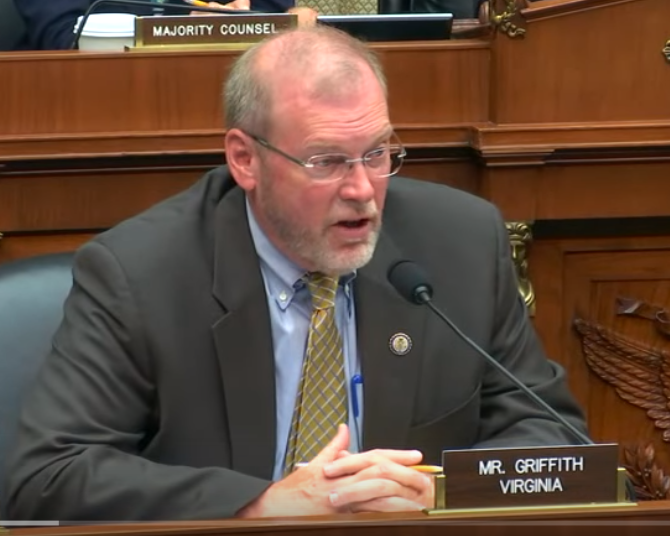By Peter Hong
In the shadows of the Senate’s failure to pass Obamacare repeal, a seemingly inconsequential, but highly revealing vote took place across the Capitol.
Congressman Morgan Griffith (R-Va.) offered an amendment to the so-called “minibus” spending bill that would have abolished the Budget Analysis division of the Congressional Budget Office (CBO). The amendment was defeated by a vote of 309-116; 120 Republicans, over half of the Republican conference, joined a unanimous bloc of Democrats to defeat it. And going down with the amendment went any real hope that this Congress – particularly Republicans – is ready to press for any real significant government oversight.
Griffith offered his amendment under the Holman Rule, which allows amendments to appropriations spending bills to fire or reduce the salary of or specific federal employees or to cut specific programs. Congressman Griffith has accurately likened the Holman Rule to firing a bullet from a sniper rifle rather than a shotgun.
And what better target practice for the first Holman Rule amendment than the CBO?
Since its creation under the 1974 Congressional Budget and Impoundment Control Act, the CBO has played a relatively quiet, but highly influential role in the lawmaking process. Then, Congress turned its attention this year to repealing and replacing Obamacare.
The CBO first made headlines in March when it projected that the original Ryancare bill in the House would throw 24 million Americans from the ranks of the insured by 2026; when the House eventually passed a modified version, the CBO only slightly revised its estimate to 23 million. Showing that its economic projection shenanigans was not simply a vendetta against House Republicans, the CBO estimated that 32 million Americans would lose their insurance coverage under the Senate bill that was defeated in late July. At every stage of the legislative process, CBO’s projections devastated Republican attempts to redress Obamacare. Who would have thought that the biggest cheerleaders for Obamacare would not be the Democrats or the mainstream media, but the green eyeshade budget geeks at the CBO?
Yet, those same projections that helped doom the Obamacare overhaul were just the latest in a series of bad predictions on health insurance by the CBO. For example, health care expert Avik Roy notes, that in 2010, when the Affordable Care Act (ACA) was passed, CBO estimated that 21 million people would enroll in the ACA exchanges in 2016. The actual number was closer to 10 million.
CBO’s forecasting deficiencies are not simply limited to health care. The CBO drastically underestimated the total price tags of the farm bills of 2002 ($137 billion off target) and 2008 ($309 billion off target). In 2012, when Congress authorized the Federal Communications Commission (FCC) to auction off spectrum, the CBO vastly undervalued the potential profit to the government at $15 billion over ten years; the first two auctions each brought in close to or more than double that amount. Referring to an auction in 2015 that brought in roughly $41 billion in revenue and the CBO’s prediction that the auction either wouldn’t happen or would bring in no revenue at all, FCC Commissioner Jennifer Rosenworcel, a Democrat, said, “Our airwaves are extraordinarily valuable but our accounting systems for measuring them in the legislative process (CBO estimates) don’t appear to be fully up to date.”
Congress cannot continue to legislate in good faith when it knows that its own signature source of economic analysis is so deeply flawed. Even if you set aside the appearance of bias against this Congress’ legislative agenda, it’s clear that a change has to be made – and in Washington, nothing ever changes without docking someone’s paycheck.
Enter the Holman Rule and the Griffith amendment. The whole purpose of the Holman Rule is to hit bureaucratic swamp dwellers right where it hurts. And what better place to start than in Congress’ backyard with federal employees who have failed the agency that hired them, the Congress that appropriates their salaries, and the taxpayers who pay for it all?
And yet, nearly three-quarters of Congress – and over half the Republicans – couldn’t bring themselves to cut 87 employees at a cost of $15 million. Adding insult to injury, according to Congressman Griffith, the CBO itself scored his amendment as budget-neutral, a bizarre projection for an amendment that directly cuts $15 million.
The defeat of this amendment does not mean the CBO gets off scot free for its deficient economic analysis; in a statement defending her “no” vote, House Budget Committee Chairman Diane Black promised hearings on the topic when Congress returns from vacation.
But the bigger picture remains grim. The Holman Rule gives Republicans an opportunity to confront the administrative state in a meaningful way – from the power of the purse. Instead of simply rescinding a handful of costly regulations, Congress can publicly call out the formerly anonymous bureaucrats who have spent their careers imposing them. That’s real government reform.
But Congress – especially the so-called Republican majority –whiffed. As Americans for Limited Government President Rick Manning put it: ”Unfortunately, 120 House Republicans chose to keep the status quo, reform-stifling Congressional Budget Office intact. This failure of House Republicans to fire the permanent ruling class in Washington, D.C. is just one more bit of evidence of how disconnected they are from the voters.”
If this Congress – particularly 120 House Republicans — refuses to cut even $15 million to place the reins on its own budget office, why should anyone believe it would ever take on the burgeoning administrative state? If past is indeed prologue, last week’s defeat of the Griffith amendment is a sad indicator it won’t.
Pete Hong is a contributing editor at Americans for Limited Government







